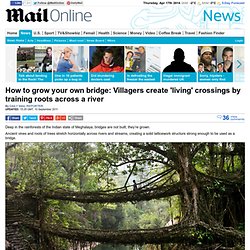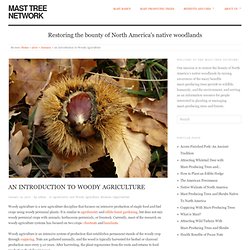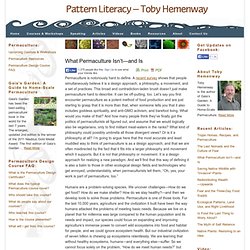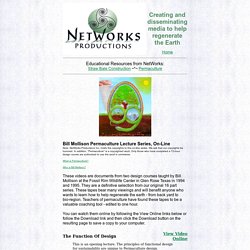

101 PERMACULTURE DESIGNS, downloadable imgur album. Meghalaya villagers create 'living' bridges by training roots across a river. By Daily Mail Reporter Updated: 15:35 GMT, 10 September 2011 Deep in the rainforests of the Indian state of Meghalaya, bridges are not built, they’re grown.

Ancient vines and roots of trees stretch horizontally across rivers and streams, creating a solid latticework structure strong enough to be used as a bridge. Ancient solution: The 'double decker' living tree root bridge in the village of Nongriat in Meghalaya, India. Locals have been using the bridges for over 500 years Some of the bridges are over a hundred feet long and can support the weight of fifty or more people. The Cherrapunji region is one of the wettest places in the world with many fast-flowing rivers and streams, making these bridges invaluable to those who live in the region. Nature's incredible engineering: Some of the bridges can hold more than 50 people at a time. Interwoven: A close up of the solid lattice work that makes the bridges so strong. Design with Nature. Agriculture. Farm Hack. Green Guerrilla #2 : fabriquer des bombes de graines. Nous vous en parlions lors du premier volet de ce petit dossier, les bombes de graines, ou “seed bombs” ou “seed grenades” ont été utilisées (et nommées) la première fois par Liz Christy en 1973 quand on commencé à NYC les premières actions de Green Guerrilla destinées à re-végétaliser les espaces urbains inhospitaliers.

Au tout début, ces armes de refleurissement massives étaient fabriquées à partir de préservatifs, de graines de fleurs sauvages et d’un mélange d’eau + engrais (ci dessous, la première recette des seeds bombs). Depuis , du chemin a été parcouru, et les seed bombs utilisées aujourd’hui s’inspirent d’une technique empruntée au japonais Masanobu Fukuoka (décédé en 2008) et père de l’agriculture du “non-agir”, encore appelée agriculture naturelle ou permaculture (nous y reviendrons dans le 3è volet de ce dossier). Toute bonne seed bomb est composée : Insect Hotels. Insect Hotels Provide a home to pollinators and pest controllers.

Tidy gardens, lawns and lack of dead wood, mean less and less habitat for wild bees, spiders and ladybugs. Permaculture - PermaWiki. Permaculture is a design system which aims to create sustainable human habitats by following nature's patterns.

The word 'permaculture', coined by Australians Bill Mollison and David Holmgren during the 1970s, is derived as a contraction of permanent agriculture, or permanent culture. The idea of permaculture is considered among the most significant innovations developed by Australians in the century since Australian federation [1]. However like "nature", the permaculture concept evolves with time making its definition difficult. For example, consider the words of Bill Mollison, I guess I would know more about permaculture than most people, and I can't define it. ... Nevertheless, today permaculture can best be described as an ethical design system applicable to food production and land use, as well as community building.
Field guides. Hope in a Changing Climate - by John D. Liu (2009) Watch Prof. Suzanne Simard talks about Mother trees. Food Forest Open Source Hub. Forest Gardening. Agriculture. Introduction to Woody Agriculture. You are here: Home > Info > Introduction to Woody Agriculture, pg. 1 Last updated October 14, 2005 Woody Agriculture refers to the intensive production of agricultural staple commodities from highly domesticated woody perennial plants.

It differs from agroforestry in that no annual crops are grown, and thus little or no tillage is performed. Permanent stands of the woody crop are established and seeds are harvested annually. Once every 5-10 years the wood is harvested for biomass by coppicing, whereupon the plants regenerate from the roots and resume production of the food crop one year later. Advantages of a woody agricultural system The concept has been developed at Badgersett Research Farm during the past 20 years. Advantages include: Decreased erosion. An Introduction to Woody Agriculture. Woody agriculture is a new agriculture discipline that focuses on intensive production of staple food and fuel crops using woody perennial plants.

It is similar to agroforestry and edible forest gardening, but does not mix woody perennial crops with annuals, herbaceous perennials, or livestock. Currently, most of the research on woody agriculture systems has focused on two crops: chestnuts and hazelnuts. Woody agriculture is an intensive system of production that establishes permanent stands of the woody crop through coppicing. Nuts are gathered annually, and the wood is typically harvested for biofuel or charcoal production once every 5-10 years.
After harvesting, the plant regenerates from the roots and returns to food production the following year. Home » USDA National Agroforestry Center (NAC) NAC Home > USDA National Agroforestry Center Home <a href="/" class="crumbStyle">Home</a> Current Issue Can windbreaks help with organic farming?

TRANSFORMING LIVES AND LANDSCAPES. Association for Temperate Agroforestry. Permacultureglobal.com - the interactive map and database of the Worldwide Permaculture Network. Cool Cat: Masanobu Fukuoka. Hugelkultur: Ultimate Raised Beds. Species Information. Paolo's Permaculture Resources. Bill Mollison: The Global Gardener - Permaculture in 4 Different Climatic Zones (1991. Permaculture Principles - thinking tools for an era of change.
What Permaculture Isn’t—and Is. Permaculture is notoriously hard to define.

A recent survey shows that people simultaneously believe it is a design approach, a philosophy, a movement, and a set of practices. This broad and contradiction-laden brush doesn’t just make permaculture hard to describe. It can be off-putting, too. Let’s say you first encounter permaculture as a potent method of food production and are just starting to grasp that it is more than that, when someone tells you that it also includes goddess spirituality, and anti-GMO activism, and barefoot living. What would you make of that? Humans are a problem-solving species. Thomas Kuhn, in his masterwork, The Structure of Scientific Revolutions, uses the word “paradigm” to mean the viewpoint that defines the problems to be solved in a particular field. Introduction to Agroecology: Green Gold- "The Source of Wealth is [are] the Functional Ecosystems"
"Kariegasfontein Ranch, Aberdeen, South Africa: Land on the left managed under Holistic Planned Grazing (HPG) in 200 mm [7.87 inches] rainfall, showing a contrast with advancing desertification," Photo Credit: Norman Kroon.
![Introduction to Agroecology: Green Gold- "The Source of Wealth is [are] the Functional Ecosystems"](http://cdn.pearltrees.com/s/pic/th/introduction-agroecology-55874086)
Source. I fixed the horizon line from original image. My last diary in this series shared Allan Savory's TED talk on his system of Holistic Management. In his talk, he made this bold statement: "There is no alternative left to mankind. " Recognizing the audacity of such a statement, I provided the following for context: Allan Savory is NOT proclaiming that Holistic Management is the only solution for climate change. In light of the acknowledgement that Holistic Management (HM in this diary) is not appropriate everywhere all the time, nor is it the only solution for climate change, I wish to present John D. The original film followed Liu as he traversed the globe documenting and inspiring large-scale projects from China, Ethiopia, and Rwanda. Bill Mollison Permaculture Lecture Series On-Line. Straw Bale Construction Straw bale construction is gaining worldwide recognition as a viable, high-performance, earth- and people-friendly building technique which utilizes a natural by-product of food production.

The Straw Bale Solution is 30-minute video introduction to straw bale building. It offers viewers an excellent look at $1.50 a square foot straw-bale homes in Mexico and the custom high-end straw-bale mansions of Santa Fe... How and why they are built, why they make so much sense and cents, and how to get started are all covered. "